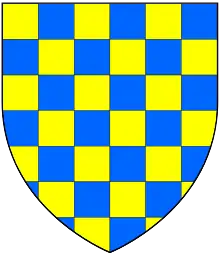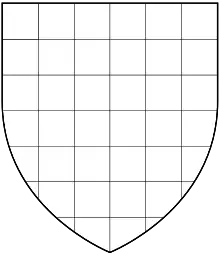Elizabeth of Vermandois, Countess of Leicester
Elizabeth of Vermandois (c. 1085 – 1131) (or Isabel), was an Anglo-Norman noblewoman, who by her two marriages was the mother of the 1st Earl of Worcester, the 2nd Earl of Leicester, the 3rd Earl of Surrey, and of Gundred de Warenne, mother of the 4th Earl of Warwick.
Elizabeth of Vermandois | |
|---|---|
 Chequy or and azure, the famous proto-heraldic coat of arms of Elizabeth of Vermandois (possibly first adopted by her brother Ralph, Count of Vermandois, as shown on his seal[1]), which she transmitted in differenced forms to her offspring | |
| Born | c. 1085 |
| Died | 13 February 1131 |
| Noble family | House of Capet |
| Spouse(s) | Robert de Beaumont, 1st Earl of Leicester William de Warenne, 2nd Earl of Surrey |
| Father | Hugh I, Count of Vermandois |
| Mother | Adelaide, Countess of Vermandois |
It is believed that she was the source of the famous chequered shield of gold and blue (or and azure) adopted at the dawn of the age of heraldry (in England circa 1200-1215) by her brother and originating before the middle of the 12th century,[2] as did only two other groups of allied English shields, the Mandeville-de Vere "quarterly shields" and the de Clare "chevron shields".[1]
Origins
She was the third daughter of Hugh I, Count of Vermandois (1057–1102) ("Hugh Magnus/Hugh the Great"), the younger son of King Henry I of France. Her mother was Adelaide of Vermandois[3] the daughter of Herbert IV, Count of Vermandois and Adele of Valois. Elizabeth thus represented both the Capetian line of her paternal grandfather King Henry I of France, and the Carolingian line of her maternal grandfather Herbert IV of Vermandois.[4]
Marriages & issue
_arms.svg.png.webp)



She was the wife successively of two Anglo-Norman magnates, firstly of Robert de Beaumont, 1st Earl of Leicester, Count of Meulan (d.1118), by whom she had twin sons, and secondly of William de Warenne, 2nd Earl of Surrey (d.1138), by whom she had a further son and a daughter Gundred de Warenne.
Marriage to Robert de Beaumont, 1st Earl of Leicester, Count of Meulan
In 1096 Robert de Beaumont, 1st Earl of Leicester, Count of Meulan (d.1118) reputed to be the "wisest man in his time between London and Jerusalem" insisted, in defiance of the laws of the Church, on marrying the very young Elizabeth, he being over fifty at the time.[5] In early 1096 Bishop Ivo, on hearing of the proposed marriage, wrote a letter forbidding the marriage and preventing its celebration on the grounds of consanguinuity, i.e. that the two were related within prohibited degrees.
In April 1086 Elizabeth's father was able to convince Pope Urban to issue a dispensation for the marriage,[4][5] and departed on the Crusade preached by that pope, his last act being to see his daughter married to Robert.
Robert was a nobleman of some significance in France, having inherited lands from his maternal uncle Henry, Count of Meulan. He gained renown fighting in his first battle, in command of the right wing, at the Battle of Hastings as one of the Proven Companions of William the Conqueror.[6][7] He was rewarded with ninety manors in the counties of Leicestershire, Northamptonshire, Warwickshire and Wiltshire.[8] The count of Meulan was one of Henry I's "four wise counsellors and was one of the king's commanders at the Battle of Tinchebray" 28 September 1106.[9] In 1107 Robert became Earl of Leicester.[10]
By de Beaumont she had three sons (the eldest of whom were twins) and five or six daughters as follows:[11]
Sons
- Robert de Beaumont, 2nd Earl of Leicester (born 1104, twin), married and left issue.[11]
- Waleran de Beaumont, 1st Earl of Worcester, Count of Meulan (born 1104, twin), married and left issue.[11]
- Hugh de Beaumont, 1st Earl of Bedford (born c. 1106), lost his earldom, left issue.[11]
Daughters
- Emma de Beaumont (born 1102),[12] betrothed as an infant to Aumari de Montfort, nephew of William, Count of Évreux, but the marriage never took place. She probably died young, or entered a convent.[13]
- Adeline de Beaumont (b c. 1107), who married firstly, Hugh IV, 4th Lord of Montfort-sur-Risle, and secondly, Richard de Granville (d. 1147), lord of the manor of Bideford in Devon.[11]
- Aubree de Beaumont (b c. 1109) (or Alberee), who married Hugh II of Châteauneuf-en-Thimerais.[11]
- Maud de Beaumont (b c. 1111), who married William Lovel.[11]
- Isabel de Beaumont (b Aft. 1102), a mistress of King Henry I of England.[14] She first married Gilbert de Clare, 1st Earl of Pembroke,[11] and later married Hervé de Montmorency, Constable of Ireland.[15]
Marriage to William de Warenne, 2nd Earl of Surrey
Elizabeth is reputed to have had an affair and left her first husband when he was near death. The historian James Planché claimed (1874) that she was seduced by or fell in love with a younger nobleman, William de Warenne, 2nd Earl of Surrey,[12] whom she married. However the evidence for such Elizabeth having had an affair is lacking. William had sought a royal bride in 1093, but failed in his attempt to wed Matilda of Scotland (also known as Edith), who later married King Henry I.[16] He married Elizabeth in 1118, very soon after the death of Robert.[17] Elizabeth survived her second husband.[3][18]
By William de Warenne she had three sons and two daughters:[19]
Sons
- William de Warenne, 3rd Earl of Surrey (1119-1148),[19] eldest son and heir;
- Ralph de Warenne[19]
- Reginald de Warenne, who inherited his father's lands in Upper Normandy, including the castles of Bellencombre and Mortemer.[20] He married Alice de Wormegay, daughter of William de Wormegay, Lord of Wormegay in Norfolk, by whom he had a son: **William de Warenne, founder of Wormegay Priory.[20]
Daughters
- Gundred de Warenne (or Gundrada), who married firstly Roger de Beaumont, 2nd Earl of Warwick (c.1102-1153) (the nephew of her mother's first husband) and had issue William de Beaumont, 3rd Earl of Warwick (c.1140-1184); secondly she married William de Lancaster, feudal baron of Kendal in Westmorland, and had issue.[19]
- Ada de Warenne (d. ca. 1178), who married Henry of Scotland, 3rd Earl of Huntingdon, younger son of King David I of Scotland, and had issue.[21] She is known as the "Queen mother of Scotland" for her two sons, Malcolm IV, King of Scotland and William I 'the Lion', King of Scotland, as well as being the ancestor of numerous other Scottish kings.[22]
Ancestry
| Ancestors of Elizabeth of Vermandois, Countess of Leicester | ||||||||||||||||||||||||||||||||||||||||||||||||||||||||||||||||||||||||||||||||||||||||||||||||||||||||||||||||||||||||||||||||||||||||||||||||||||||||||||||||||||||||||||||||||||||||||||||||||||||||||||||||||||||||||||||||||||||||||||||||||||||||||||||||||||||||||||||||||||||||||||||||||||||||||||||||||||||||||||||||||||||||||||||||||||||||||||||||||||||||||||||||||||||||||||||||||||||||||||||||||||||||||||||||||||||||||||||||||||||||||||||||||||||||||||||||||||||||||||||||||||||||||||||||||||||||||||||||||||||||||||||||||||||||||||||||||||||||||||||||||||||||||||||||
|---|---|---|---|---|---|---|---|---|---|---|---|---|---|---|---|---|---|---|---|---|---|---|---|---|---|---|---|---|---|---|---|---|---|---|---|---|---|---|---|---|---|---|---|---|---|---|---|---|---|---|---|---|---|---|---|---|---|---|---|---|---|---|---|---|---|---|---|---|---|---|---|---|---|---|---|---|---|---|---|---|---|---|---|---|---|---|---|---|---|---|---|---|---|---|---|---|---|---|---|---|---|---|---|---|---|---|---|---|---|---|---|---|---|---|---|---|---|---|---|---|---|---|---|---|---|---|---|---|---|---|---|---|---|---|---|---|---|---|---|---|---|---|---|---|---|---|---|---|---|---|---|---|---|---|---|---|---|---|---|---|---|---|---|---|---|---|---|---|---|---|---|---|---|---|---|---|---|---|---|---|---|---|---|---|---|---|---|---|---|---|---|---|---|---|---|---|---|---|---|---|---|---|---|---|---|---|---|---|---|---|---|---|---|---|---|---|---|---|---|---|---|---|---|---|---|---|---|---|---|---|---|---|---|---|---|---|---|---|---|---|---|---|---|---|---|---|---|---|---|---|---|---|---|---|---|---|---|---|---|---|---|---|---|---|---|---|---|---|---|---|---|---|---|---|---|---|---|---|---|---|---|---|---|---|---|---|---|---|---|---|---|---|---|---|---|---|---|---|---|---|---|---|---|---|---|---|---|---|---|---|---|---|---|---|---|---|---|---|---|---|---|---|---|---|---|---|---|---|---|---|---|---|---|---|---|---|---|---|---|---|---|---|---|---|---|---|---|---|---|---|---|---|---|---|---|---|---|---|---|---|---|---|---|---|---|---|---|---|---|---|---|---|---|---|---|---|---|---|---|---|---|---|---|---|---|---|---|---|---|---|---|---|---|---|---|---|---|---|---|---|---|---|---|---|---|---|---|---|---|---|---|---|---|---|---|---|---|---|---|---|---|---|---|---|---|---|---|---|---|---|---|---|---|---|---|---|---|---|---|---|---|---|---|---|---|---|---|---|---|---|---|---|---|---|---|---|---|---|---|---|---|---|---|---|---|---|---|---|---|---|---|---|---|---|---|---|---|---|---|---|---|---|---|---|---|---|---|---|---|---|---|---|---|---|---|---|---|---|---|---|---|---|---|---|---|---|---|---|---|---|---|---|---|---|---|---|---|---|---|---|---|---|---|---|---|---|---|---|---|---|---|---|---|---|---|---|---|---|---|---|---|---|---|---|---|---|---|---|---|---|---|---|---|---|---|---|---|---|---|---|---|---|---|---|---|---|---|---|---|---|---|---|---|---|---|---|
| ||||||||||||||||||||||||||||||||||||||||||||||||||||||||||||||||||||||||||||||||||||||||||||||||||||||||||||||||||||||||||||||||||||||||||||||||||||||||||||||||||||||||||||||||||||||||||||||||||||||||||||||||||||||||||||||||||||||||||||||||||||||||||||||||||||||||||||||||||||||||||||||||||||||||||||||||||||||||||||||||||||||||||||||||||||||||||||||||||||||||||||||||||||||||||||||||||||||||||||||||||||||||||||||||||||||||||||||||||||||||||||||||||||||||||||||||||||||||||||||||||||||||||||||||||||||||||||||||||||||||||||||||||||||||||||||||||||||||||||||||||||||||||||||||
References
- G. E. Cokayne, The Complete Peerage, n.s., Vol. XII, Part 1, Appendix J, "The Warenne Group of Chequered Shields", pp.26-9, note b
- G. E. Cokayne, The Complete Peerage, n.s., Vol. XII, Part 1, Appendix J, "The Warenne Group of Chequered Shields", pp.26-9
- Detlev Schwennicke, Europäische Stammtafeln: Stammtafeln zur Geschichte der Europäischen Staaten, Neue Folge, Band III Teilband 4, (Marburg, Germany: Verlag von J. A. Stargardt, 1989), Tafel 699
- Detlev Schwennicke, Europäische Stammtafeln: Stammtafeln zur Geschichte der Europäischen Staaten, Neue Folge, Band III Teilband 1, Herzogs und Grafenhäuser des Heiligen Römischen Reiches Andere Europäiche Fürstenhäuser (Marburg, Germany: Verlag von J. A. Stargardt, 1984), Tafel 55
- Edmond Chester Waters, 'Gundrada de Warenne', The Archaeological Journal, Vol. xli (London, 1884), p. 308-9
- George Edward Cokayne, The Complete Peerage, Vol. XII/1 (The St. Catherine Press, London, 1953), Appendix L, pp. 47–8, Appendix L, The Battle of Hastings and the Death of Harold (List of those known to be at the Battle of Hastings)
- David C. Doulgas, William the Conqueror (University of California Press, 1964), p. 203
- J. R. Planché, The Conqueror and His Companions, Vol. I (Tinsley Bros., London, 1874) p. 206
- C. Warren Hollister, Henry I (Yale University Press, New Haven & London, 2003) pp. 132–3, 199–200
- K.S.B. Keats-Rohan, Domesday People, a Prosopography of Persons Occurring in English Documents 1066–1166 (The Boydell Press, Woodbridge, 1999), p. 371
- George Edward Cokayne, The Complete Peerage, Vol. VII (The St. Catherine Press, Ltd, 1929), p. 540
- J. R. Planché, The Conqueror and His Companions, Vol. I (Tinsley Bros., London, 1874) p. 212
- J. R. Planché, The Conqueror and His Companions, Vol. I (Tinsley Bros., London, 1874) p. 216
- George Edward Cokayne, The Complete Peerage, Vol. VII (The St. Catherine Press, Ltd, 1929), p. 526, footnote (c)
- Proceedings of the Suffolk Institute of Archaeology and Natural History, Bol. II, No. 1, (1854), p. 311
- C. Warren Hollister, Henry I (Yale University Press, New Haven & London, 2003)p. 340
- C. Warren Hollister, 'The Taming of a Turbulent Earl: Henry I and William of Warenne', Historical Reflections, Vol. 3 (1976) p. 90 n. 36
- G. E. Cokayne, The Complete Peerage, Vol. XII/1 (The St. Catherine Press, London, 1953) p. 496
- William Farrer, Charles Travis Clay, Early Yorkshire Charters, Volume VIII – The Honour of Warenne (The Yorkshire Archaeological Society, 1949) p. 10
- William Farrer, Charles Travis Clay, Early Yorkshire Charters, Volume VIII – The Honour of Warenne (The Yorkshire Archaeological Society, 1949) pp. 27–8
- William Farrer, Charles Travis Clay, Early Yorkshire Charters, Volume VIII – The Honour of Warenne (The Yorkshire Archaeological Society, 1949) p. 11
- Victoria Chandler, 'Ada de Warenne, Queen Mother of Scotland (c. 1123–1178)', The Scottish Historical Review, Vol. 60, No. 170, Part 2 (October 1981), pp. 119–139
External links
- Elizabeth de Vermandois on thepeerage.com